Basil Balsamic Vinaigrette
This page contains affiliate links. For more information please read my Disclosure Policy.
Basil Balsamic Vinaigrette is an easy, flavorful homemade dressing recipe with a few simple ingredients. Whip up this fresh basil vinaigrette with a rich balsamic vinegar to add big flavor to fresh salads or chicken.
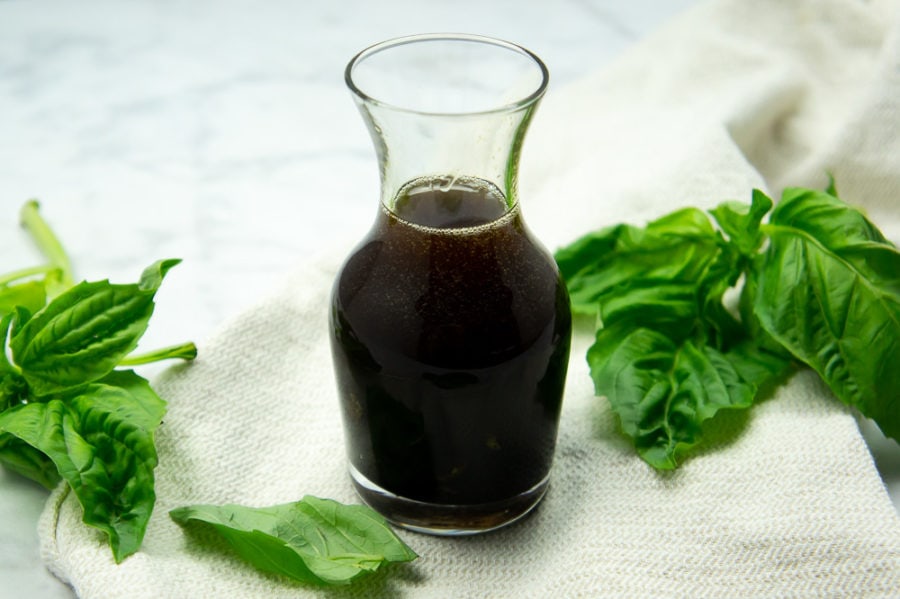
A homemade vinaigrette is hard to beat when it comes to easily adding flavor to your food. They’re so easy and delicious, I have a whole post dedicated to the vinaigrette! But…I’ll be honest, I’m not a big salad fan, I’d much rather eat a giant bowl of pasta…but my health sometimes demands those greens, and nothing makes it better than this simple but flavorful basil balsamic vinaigrette.
What makes this recipe even better than how quickly you can make it? It lasts a week in the fridge and you can easily drizzle your basil balsamic dressing over more than just greens. Try it on chicken, roasted potatoes, and yes, even that big bowl of pasta.
What is Balsamic Vinegar?
You’ve got it in your cupboard, you love it, but what exactly is balsamic vinegar? Balsamic vinegar is a rich, deeply concentrated fermented product of grape must.
Grape must is basically crushed sweet grape juice that is boiled, concentrated, fermented and then aged for 12+ years until it transforms into rich, slightly sweet balsamic vinegar. At least that’s how the traditional stuff is made.
Most commercial balsamic vinegar is made with a combination of grape must and wine vinegar to expedite the process, and it’s aged for months, not years. While it still has big flavor, it’s different than the traditional balsamic you’d get out of the Modena region in Italy.
These vinegars can range in sweetness, acidity and thickness based upon how long it was aged and how it was made. I recommend looking for a small batch production, or one that is certified by IGP, DOP, or PDO (European authenticity labels) for the biggest flavor for your buck.
Ingredients
To whip up a quick batch of basil balsamic vinaigrette you only need a few basic ingredients, 6 to be exact. (2 are salt and pepper, so let’s call those freebies).
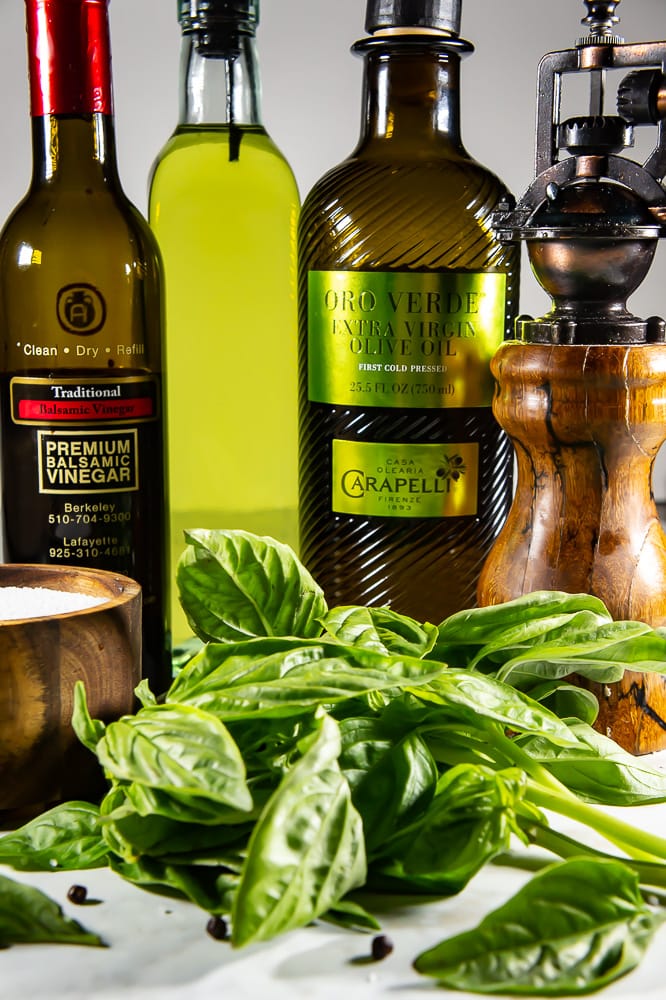
- Olive Oil – A nice, fresh extra virgin olive oil for flavor and richness
- Canola or Vegetable Oil – Make the dressing cheaper to make, and prevents solidifying in the fridge.
- Balsamic Vinegar – Get a good one! I prefer a thinner balsamic for this, not a thick syrupy one. Avoid products labeled balsamic reduction for this recipe.
- Fresh Basil – Use 7 to 8 fresh, bright green leaves of basil for this!
- Salt & Pepper – Coarse kosher salt and fresh cracked black pepper are my preference when making this.
How to make Basil Balsamic Vinaigrette
To whip this up, it will only take you a few minutes and it stays good in your fridge for up to a week. This recipe makes about 1.5 cups, perfect for a week of drizzling. There are a few ways to make this, and I’ve listed details for each below.
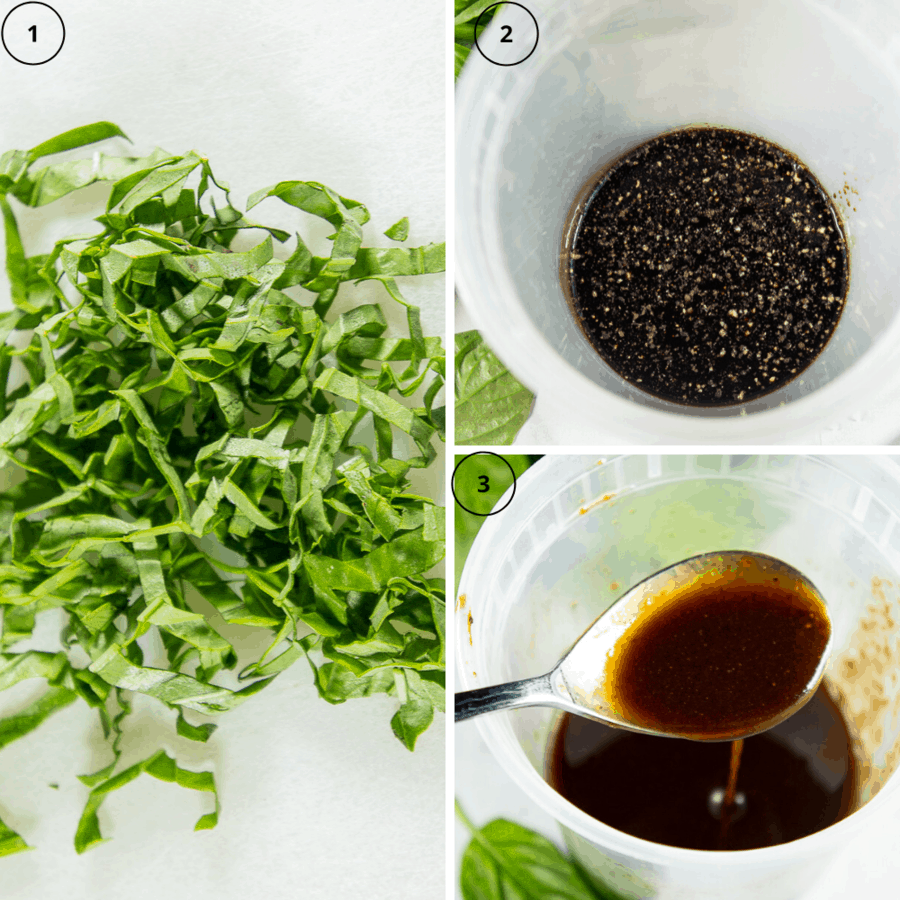
By Hand:
- First, layer the leaves of your basil on top of each other, then roll tightly into a cigar shape. Slice thin ribbons then set aside.
- Combine balsamic, salt, and pepper into a large bowl.
- Combine your oils, then while whisking, begin to slowly drizzle them in.
- When the dressing begins to come together (look uniform, without oil separated out), begin adding the oil a little faster.
- Add sliced basil, whisk, and use.
With Blender
- Slice basil as directed above.
- Combine the balsamic, salt, and pepper into your blender, and pulse to combine.
- Add oil to blender and pulse in 5 to 10 second increments until it comes together.
- Transfer to a storage bowl or jar and add basil, stirring or shaking to combine.
I like to use my immersion blender for this, as it allows me to control the blending speed a little better, and I can mix it in my storage container.
With Mason Jar
- Slice basil, and combine with all other ingredients in a large mason jar.
- Shake vigorously until the vinaigrette has come together.
Pro TIPS
- Regardless of the method you use, store any extra in an airtight container in the fridge for up to 1 week. Shake well before using.
- This vinaigrette contains no emulsifiers, meaning oil and vinegar are fighting pretty hard to stay apart. Even with the blender, your vinaigrette will have some natural separation in the fridge. Shaking well will return it to it’s mixed state long enough to use.
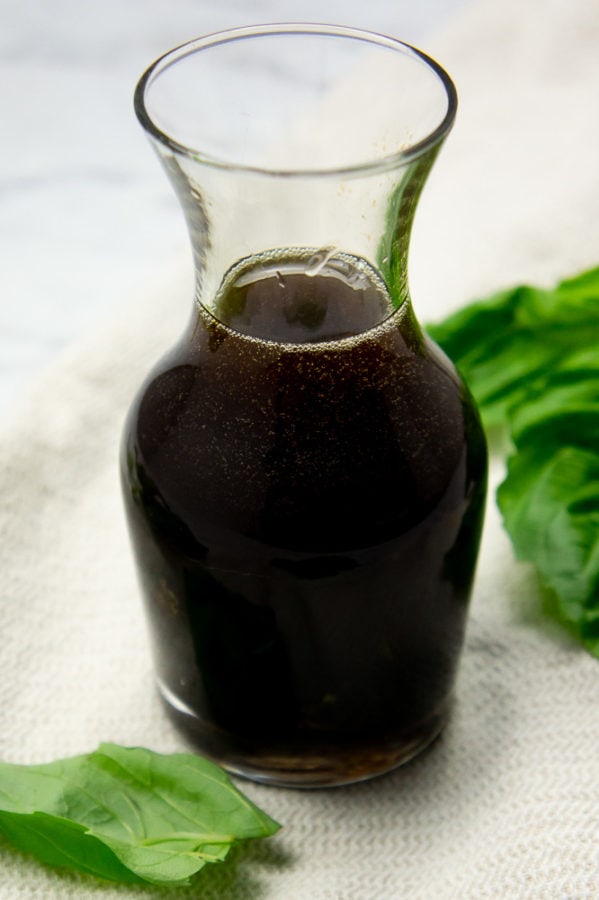
FAQ’s
This recipe is really for a fresh basil vinaigrette. Using dry is possible, but will not produce the same flavor or texture in the dressing.
Eat & Enjoy
Simple, right? It’s hard to beat how simple this is to make, and it’s equally easy to use it, one more than just your salads. Below are some recommendations for using this basil balsamic vinaigrette, and until next time, Happy Eating!
- Brussels Sprouts Salad
- Cold Chicken Spinach Pasta Salad
- Potato Goat Cheese Cakes with European Salad
- Farro Salad
- Tomato Spinach Salad
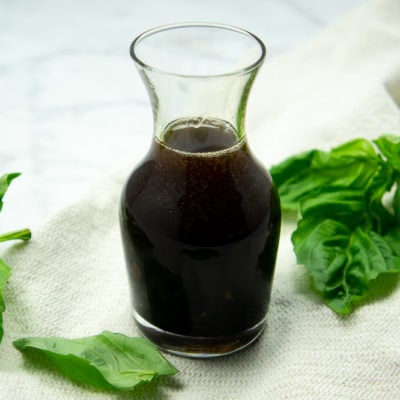
Basil Balsamic Vinaigrette
Ingredients
- 1/4 cup balsamic vinegar
- 1/2 tsp kosher salt
- 1/4 tsp black pepper
- 1/2 cup Extra Virgin Olive Oil
- 1/2 cup Canola Oil
- 2 Tbs fresh basil about 7-8 leaves
Instructions
- Layer your leaves of basil, roll into cylinder (cigar shape) and slice into ribbons, set aside.
By Hand Mixing
- Add salt, pepper, and balsamic vinegar to a bowl. Whisk to combine.
- Combine your oils and begin slowly drizzling into your vinegar, whisking continuously until all your oil is added.
- Add chopped basil to vinaigrette and stir to combine. Refrigerate until ready to serve*, up to 1 week.
Blender Mixing (Immersion or Upright blender)
- Combine vinegar, salt, and pepper and pulse to combine.
- Add oil and pulse in 5 to 10 second increments until completely combined.
- Transfer to a container, add in basil and mix. Refrigerate until ready to serve, up to one week.
Mason Jar Mixing
- Combine all ingredients in a mason jar and shake vigorously until it all comes together.
- Refrigerate until ready to serve, up to 1 week.
Notes
Nutrition
Originally published 1/8/2018, Updated 1/1/2020
Nutrition information and cooking times are provided as a best estimate. Values may vary based upon ingredients and equipment.

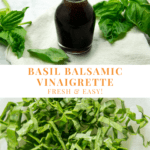
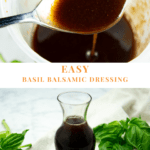
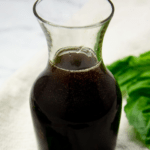

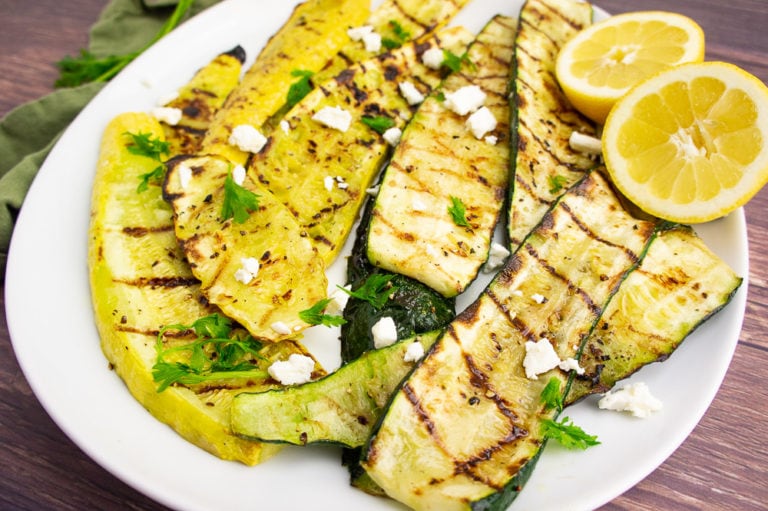

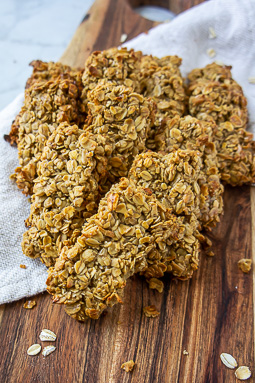



This dressing looks tasty and can go with such a variety of different salad recipes! Thanks, can’t wait to try
I hope you enjoy!
We enjoy freshening up our salads with different dressings. Basil is such a wonderful herb and we are so glad we have plenty. Will be making this soon. It’s time we added some zing to our salad.
I hope you enjoyed it Marisa!
Can’t wait to make this and use it in my summer salads. So delicious
Thanks! Glad you like it 🙂
I love trying new vinaigrette flavors and this looks absolutely amazing! Definitely need to make it and try with a few of my favorite salads!
I hope you like it Veronika, it’s one of my faves!
The perfect, simple salad dressing. We are excited to put this one into the regular rotation. Thank you for the great recipe!
Simple is sometimes best right?! I’m glad you enjoyed it Candice!
Mmmm! I don’t use dressing very often but when I do, I always make it from scratch. This dressing would be great on so many things…and maybe as a marinade too.
It works great as a marinade, I hope you enjoy it!
I marinated last night’s chicken in this balsamic vinaigrette and I don’t think I’ll ever make my chicken any other way! Easy to make and so flavorful.
That’s a great way to use this! I’m SO glad you liked it! Thanks for making my day 🙂
I love this idea and now all I can think about is making this and enjoying a fresh salad! I know what I am having for lunch today.
It’s perfect for lunch, it comes together so fast! I think I’ll be doing the same 🙂
I used my fresh basil for this recipe and it was so perfect! I doubled the recipe so I could have more! Very easy to make too!
So glad you enjoyed the recipe Kathryn!
I love making my own dressing and now that basil is in abundance I can’t wait to try this balsamic basil version!
It’s definitely the right time of year to whip this up 🙂 I hope you enjoy!
This vinaigrette is lovely! I just love that fresh basil flavor, and it will go well with so many salads all summer.
It does! I even drizzle it over straight sliced tomatoes, it’s so good!
Such a classic dressing and oh so good! No need to ever buy those terribly unhealthy dressings from the store when this is so easy and delicious! Thanks for including my potato goat cheese cakes and salad recipe!
I agree, so much easier to make dressing at home, and easy to customize too! I thought you recipe would be particularly delicious with this recipe!